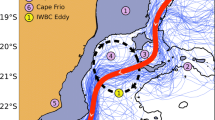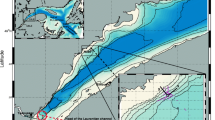Abstract
The generation and propagation mechanisms of a Kyucho and a bottom intrusion in the Bungo Channel, Japan, have been studied numerically using the hydrostatic primitive equations by assuming density stratification during summer. The experiments are designed to generate a Kuroshio small meander in Hyuga-Nada, which acts as a trigger for these disturbances. After the current speed of the Kuroshio is changed, a small meander is generated. At the head of the small meander, warm Kuroshio water is engulfed, and encounters the southwest coast of Shikoku. However, convergence of heat flux on the bump off Cape Ashizuri suppresses the generation of a warm disturbance, if the current speed is large. As the cold eddy associated with the small meander approaches Cape Ashizuri, the heat flux diverges on the bump. This heat source forces a warm disturbance, which intrudes along the east coast of the Bungo Channel as a baroclinic Kelvin wave (a Kyucho). After the cold eddy passes off Cape Ashizuri, the Kuroshio approaches the bump again. Strong convergence of heat flux then occurs on the bump, which forces a cold disturbance. This disturbance propagates as a topographic Rossby wave along the shelf break at the mouth of the channel. After the topographic wave reaches the west end of the shelf break, it intrudes along the bottom layer of the channel as a density current (a bottom intrusion). These results suggest that a Kyucho and a bottom intrusion are successive events associated with the propagation of the small meander.
Similar content being viewed by others
References
Akitomo, K., S. Masuda and T. Awaji (1997): Kuroshio path variation south of Japan: Stability of the paths in a multiple equilibrium regime. J. Oceanogr., 53, 129–142.
Akiyama, H. and S. Saitoh (1993): The Kyucho in Sukumo Bay induced by Kuroshio warm filament intrusion. J. Oceanogr., 49, 667–682.
Arai, M. (2004): Development of a semi-spectral coastal ocean model and its application to the Neko Seto Sea in the Seto Inland Sea. J. Oceanogr., 60, 597–611.
Beckman, A. and. D. B. Haidvogel (1993): Numerical simulation of flow around a tall isolated seamount. Part I: Problem formulation and model accuracy. J. Phys. Oceanogr., 23, 1736–1753.
Ebuchi, N. and K. Hanawa (2001): Trajectory of mesoscale eddies in the Kuroshio recirculation region. J. Oceanogr., 57, 471–480.
Endoh, T. and T. Hibiya (2000): Numerical study of the generation and propagation of trigger meanders of the Kuroshio south of Japan. J. Oceanogr., 56, 409–418.
Endoh, T. and T. Hibiya (2001): Numerical simulation of the transient response of the Kuroshio leading to the large meander formation south of Japan. J. Geophys. Res., 106, 26833–26850.
Griffiths, R. W. (1986): Gravity currents in rotating systems. Ann. Rev. Fluid Mech., 18, 59–89.
Kaneda, A., H. Takeoka, E. Nagaura and Y. Koizumi (2002): Periodic intrusion of cold water from the Pacific Ocean into the bottom layer of the Bungo Channel in Japan. J. Oceanogr., 58, 547–556.
Kawabe, M. (1995): Variations of current path, velocity, and volume transport of the Kuroshio in relation with the large meander. J. Phys. Oceanogr., 25, 3103–3117.
Kawabe, M. (1996): Model study of flow conditions causing the large meander of the Kuroshio south of Japan. J. Phys. Oceanogr., 26, 2449–2461.
LeBlond, P. H. and L. A. Mysak (1978): Waves in the Ocean. Elsevier Scientific Publishing Company, Amsterdam, 602 pp.
Lee, T. N., L. P. Atkinson and R. Legeckis (1981): Observations of a Gulf Stream frontal eddy on the Georgia continental shelf, April 1977. Deep-Sea Res., 28A, 347–378.
Lilly, D. K. (1965): On the computational stability of numerical solutions of time-dependent non-linear geophysical fluid dynamics problems. Mon. Wea. Rev., 93, 11–26.
Mellor, G. L., T. Ezer and L.-Y. Oey (1994): The pressure gradient conundrum of sigma coordinate ocean models. J. Atmos. Oceanic Technol., 11, 1126–1134.
Takeoka, H. and T. Yoshimura (1988): The Kyucho in Uwajima Bay. J. Oceanogr. Soc. Japan, 44, 6–16.
Takeoka, H., H. Akiyama and T. Kikuchi (1993): The Kyucho in the Bungo Channel, Japan—Periodic intrusion of oceanic warm water. J. Oceanogr., 49, 369–382.
Takeoka, H., Y. Tanaka, Y. Ohno, Y. Hisaki, A. Nadai and H. Kuroiwa (1995): Observation of the Kyucho in the Bungo Channel by HF radar. J. Oceanogr., 51, 699–711.
Takeoka, H., Y. Koizumi and A. Kaneda (2000): Year-to-year variation of a kyucho and a bottom intrusion in the Bungo Channel, Japan. p. 197–215. In Interactions between Estuaries, Coastal Seas and Shelf Seas, ed. by T. Yanagi, Terra Scientific Publishing Company, Tokyo.
Waseda, T., H. Mitsudera, B. Taguchi and Y. Yoshikawa (2003): On the eddy-Kuroshio interaction: Meander formation process. J. Geophys. Res., 108, 3220, 10.1029/2002JC001583.
Yamagata, T. (1980): A theory for propagation of an oceanic warm front with application to Sagami Bay. Tellus, 32, 73–76.
Author information
Authors and Affiliations
Corresponding author
Rights and permissions
About this article
Cite this article
Arai, M. Numerical Study of a Kyucho and a Bottom Intrusion in the Bungo Channel, Japan: Disturbances Generated by the Kuroshio Small Meanders. J Oceanogr 61, 953–971 (2005). https://doi.org/10.1007/s10872-006-0012-3
Received:
Revised:
Accepted:
Issue Date:
DOI: https://doi.org/10.1007/s10872-006-0012-3




